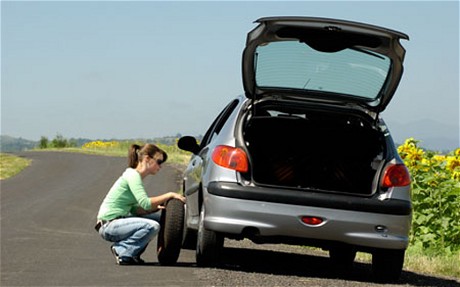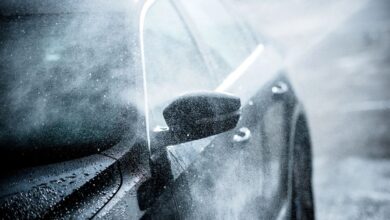20 Things every 20 something should know about cars

you are twenty something, meaning you are slowly entering adulthood. You are beginning to take ownership over apartments, cars, etc. Along the way there are things you need to know and are going to discover. One of them would be driving a car.
How to change the Tire
Follow the six simple steps:
• Find a safe spot to pull over
• Turn on your hazard lights
• Use the wrench to loosen the lug nuts
• Use the jack to lift the vehicle off the ground
• Remove the lug nuts and pull the tire off the car
• Place the spare on the car
• Put on the lug nuts
• Lower the car back to the ground
• Make sure the lug nuts are tightened
• Put the flat tire and tools back in the trunk
How to check the tire temperature
Driving with over- or under-inflated tires is a dangerous and unnecessary hazard. Buy a tire-pressure gauge, quickly press it onto the inflation nipple, and see how much pressure it reads. Every car should have a warning inside the driver-side door that lists the optimum pressure for the front and rear tires
How to check the oil
Take the following steps to check your car oil level:
• Remove the dipstick and wipe it off
• Replace the dipstick and wait a few seconds before removing it again to read the oil level
• Compare the oil level with the MIN and MAX marks
• Wait for ten minutes before rechecking the oil level and repeat it until it reaches the MAX mark. But don’t go above this mark
• Replace the dipstick
Understand that different cars will react differently
There are a few ways to move a car car: via the front wheels, rear wheels, or all wheels. Front-wheel drive is the most popular, and in low-traction conditions can cause you to plow ahead, even though you have the wheel fully-turned. Rear-wheel-drive is popular for high-performance cars but can cause you to lose the tail end of the vehicle if driven dangerously. All-wheel drive and four-wheel drive are the safest for tricky conditions and will send power to the wheels with the most traction.
Keep maintenance log
Keeping a Vehicle Maintenance Log Solves The Problem Of Trying To Remember
Learn how to drive a standard transmission
Ten steps to drive one:
• Know your way around the gears
• Learn the gears
• Starting the gear
• Using the clutch
• Upshifting
• Downshifting
• Reverse
• Starting on a hill
• Parking
• Practice!
What to keep in your glove box
Insurance information, registration, a flashlight, and a first-aid kit are all must-have items for your glove box. You could also keep some gloves in there.
How to maintain traction in rain
If weather conditions are bad, learn to keep your foot light in such conditions. This decreases the chances of the vehicle slipping, losing control or being involved in collisions.
How to parallel park
Nine steps to parallel park:
• Find a suitable space
• Study the space as you drive up
• Claim the space and position yourself to back in
• Get help (optional)
• Turn and prepare to back in
• Back most of the way in
• Straighten out as you finish pulling in
• Pull the front up to the curb and center the car
• At this point if all went well, you should be tucked in nicely
How to control a slide
This is sommer advanced winter driving. Slow down and try to drive out of it with a very light, even pressure on the accelerator. Do not turn the wheels and do not attempt any sudden movements. If you even feel the wheels beginning to slip stop and let nature take its course as you will likely backup and out of the area that started the wheel spin.
How to get unstuck
Steps to get unstuck:
• Don’t panic
• Gently push on the accelerator to try to ease out of the mud pit.
• Rock the car back and forth
• Let a little air out of the tires
• Find something to place under the tires to provide traction
• Get help. Call a tow truck or a friend that has a wench to come and rescue you.
Let your car warm up before you use it
The engine coolant temperature sensor in your car’s engine, together with its inlet air sensor work together to decide the operating of your cars engine at start up. When it is cold the fuel injectors are commanded to inject extra fuel, and your cars idle speed control valve is commanded to increase idle speed to prevent the engine stalling from a now richer mixture. As the engine warms up, the engine management system trims it back to the lower idle speed you describe. This is what it is supposed to do. As long as the temperature does not drop to the point where it freezes the engines oil, driving the vehicle considerately will not harm the engine. The advances in the technology of metals used today afford them properties way in excess of what they were a couple of decades ago. Simply put the engine runs better when it’s at its operating temperature, take it easy till then. In extreme cold conditions an engine block heater set up may be a good idea.
Be able to describe problems to your mechanic
Mechanics need details to diagnose a problem. If you show up and say “it’s broken,” it will take a lot longer to diagnose the issue than if you say “the brakes are too squishy” or “the tires are shaking on the highway.”
Always pass on the right
Don’t be that annoying guy to pass cars on the left hand side where slow traffic is at. Keep left pass right. Simple!
How to spot police cars
Be able to spot the police. Know these cars, and know their headlights for night driving. As for unmarked? It is very difficult to tell.
How to check fluid levels
Ten steps to check fluid levels on your car:
• Your owner’s manual tells you when fluids must be checked, but this is just the minimum to keep your warranty in effect.
• Park the car on a flat, level surface and set the parking brake.
• Open the hood
• Check the motor oil
• Check the transmission fluids
• Check the brake fluid
• Check the power steering fluid
• Check the coolant
• Check the windshield washer fluid
• Check your tire pressure
How to change a headlight
Follow these steps to change the headlight bulb on your vehicle:
• Open the engine compartment hood.
• Locate the back of the headlight to determine the lamp and bulb type.
• Decide which bulb you need to replace.
• Purchase the correct bulb for your headlamp.
• Follow the directions in the service manual for the correct way to replace the bulb
How to jump-start a car battery
Steps to jump start a car battery:
• Make sure the battery is the problem
• Open each car’s hood
• Park the working car near the disabled car
• Put on a safety gear
• Untangle and unwind your jumper cables. Like your batteries, your jumper cables will probably have red and black cables and will have heavy duty clamps to connect to the battery terminals. You must make sure that the red and black ends of your jumper cables never touch each other once they are connected to the batteries; permitting them to do so can result in serious arcing and/or damage to one or both cars.
• Connect the jumper cables
• Start the working car
• Try to start the disabled vehicle
• Remove the jumper cables once the car stars
• Keep the recently-disabled car’s engine running
Know what the numbers on gas pumps mean and which your car needs
Select the correct grade of gasoline (or diesel — we know a girl who once put diesel in a regular engine) for your car.
Any car can be a “cool” car
It doesn’t matter what car you are driving, so long as you take good care of it and it can move you from point A to point B.




